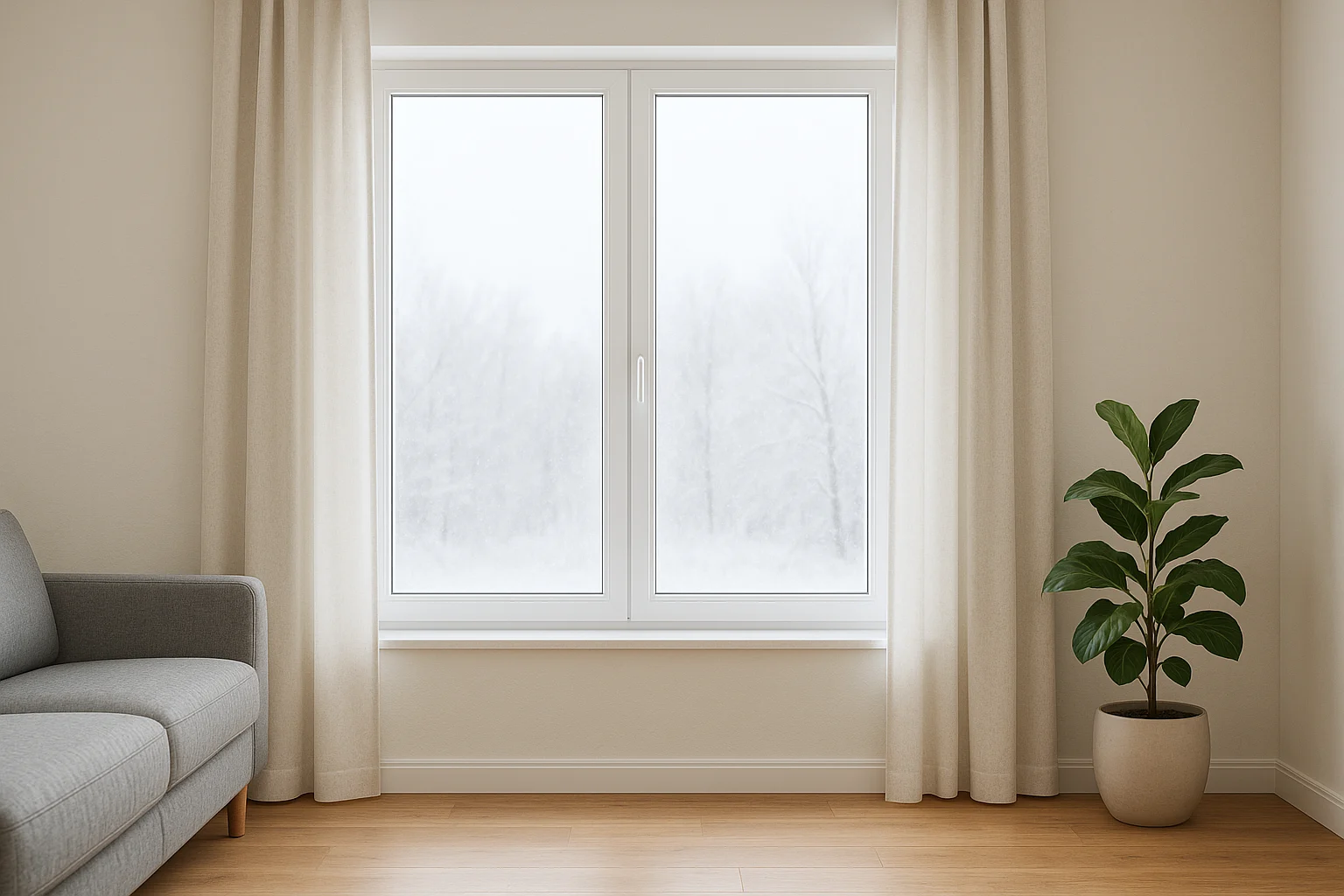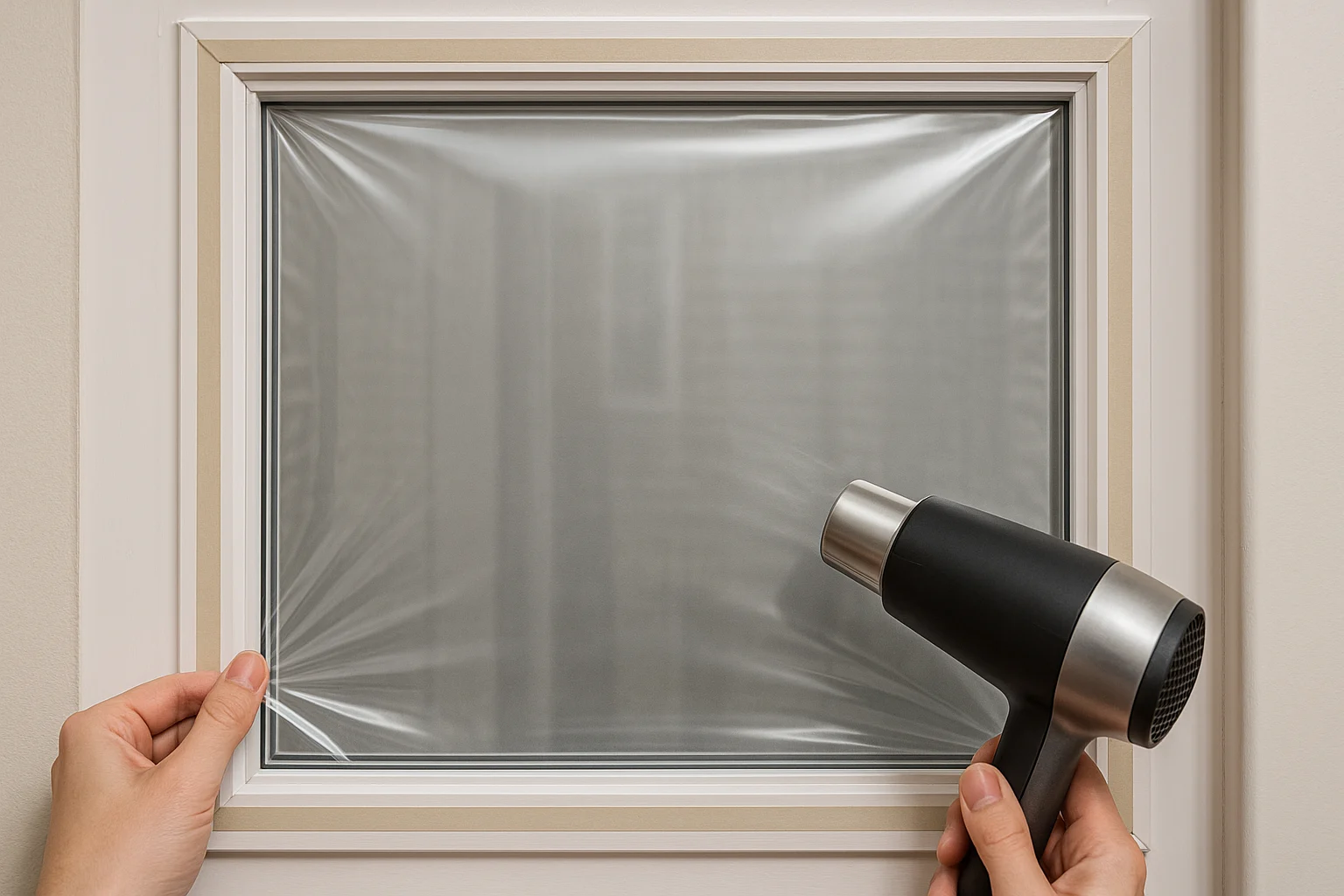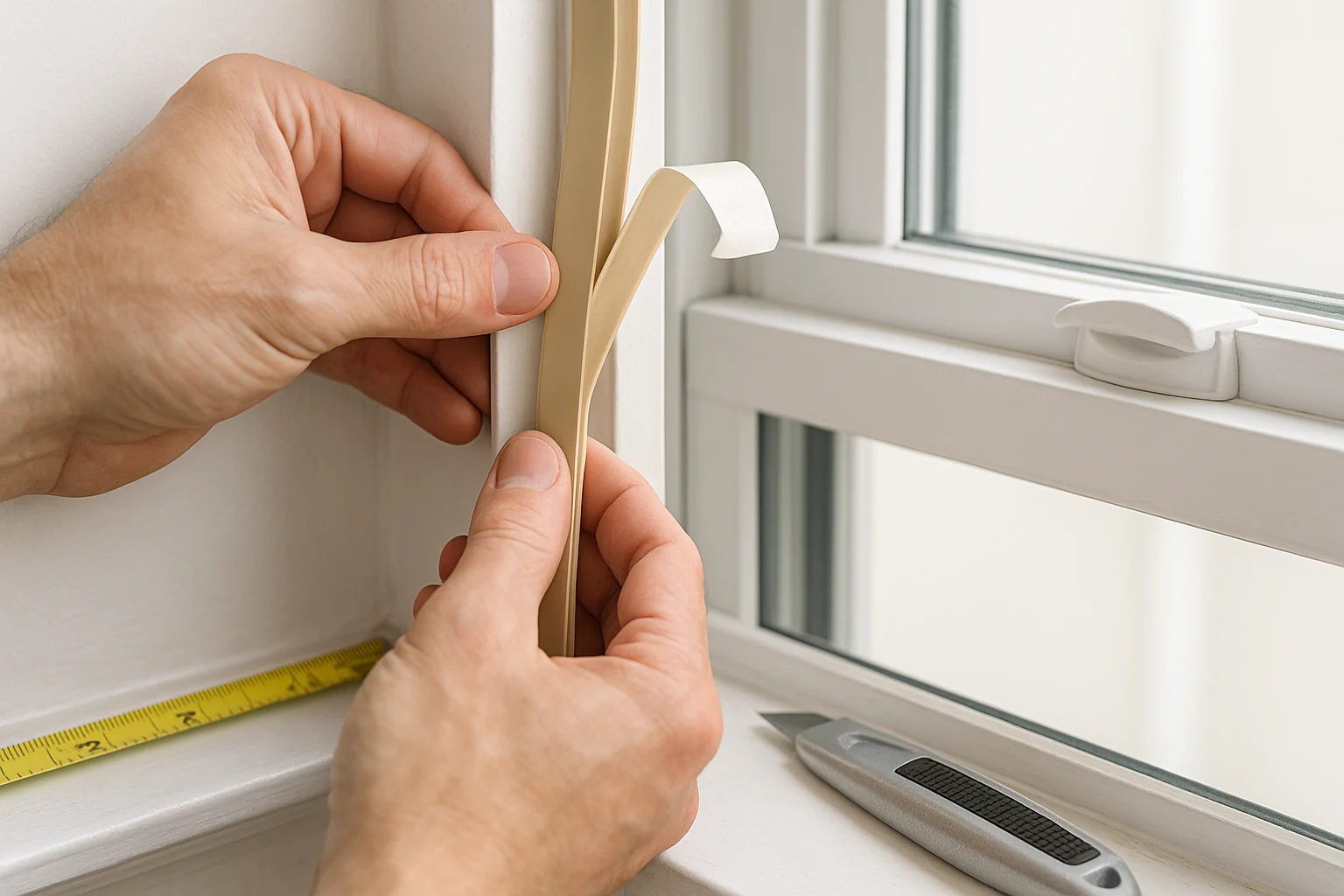
Drafty in winter, hot in summer? This window insulation how to guide shows you how to tighten leaky frames fast—what to seal first, the cheapest wins (plastic film kits, weatherstripping, caulk), and when to step up to thermal curtains or diy window inserts. Plan for a weekend of work and a noticeable comfort boost; many homes may see roughly 10–25% lower heating and cooling costs, depending on climate and baseline leaks. No special tools, renter-friendly paths included. For rebates and credits that stack with your upgrades, see our guide to energy efficient home improvement credits.
Your Best-Fit Window Insulation Tool
Answer a few quick questions to estimate savings and get a tailored suggestion.
Current window condition
Add your average monthly bill and choose your current window condition. We’ll estimate annual savings and suggest your next best step.
💡 Tip: If you’re unsure, start with “Untreated • many drafts.”
This page contains paid/affiliate links. As an Amazon Associate we earn from qualifying purchases, and we may earn commissions from other partners—at no extra cost to you. Links marked with ‘#ad’ are affiliate links, meaning we may earn a commission at no extra cost to you. Learn more.
Table of Contents
- Your Best-Fit Window Insulation Tool
- Window Insulation How To: Stay Warm in Winter, Cool in Summer
- Key Takeaways
- Why Insulating Windows Saves Money & Comfort
- How Heat Escapes Through Windows (and What to Fix)
- Window Insulation How To: DIY Methods (Quick → Advanced)
- Seasonal Adjustments: How to Insulate Windows for Winter (and Summer)
- Cost vs. Energy Savings: A Smart Investment
- Success Stories and Real-World Impact
- Frequently Asked Questions
- Conclusion: Take Control of Your Home’s Comfort in 2025!
Window Insulation How To: Stay Warm in Winter, Cool in Summer
Tired of winter drafts and summer heat? You don’t need brand-new windows to feel a real difference. With a few low-cost fixes and an afternoon of work, you can tighten leaky frames, calm hot and cold spots, and stop paying to heat or cool the outdoors. If you’re after diy window insulation for winter or diy window insulation for summer, you’ll find both covered below.
Key Takeaways
- Real Savings & Comfort: Properly insulating your windows can reduce bills by 10–25% and nix drafts/hotspots.
- Start Cheap, Then Upgrade: plastic film kits, foam tape → step up to thermal curtains or diy window inserts.
- Renter-Friendly: Rope caulk and shrink film peel off cleanly; tension-rod curtains leave no marks.
- Year-Round Benefits: Seals help in winter and summer (humidity control, radiant heat).
- Fast Wins: Most projects finish in an afternoon with basic tools.
Why Insulating Windows Saves Money & Comfort
Windows are often the weakest link in your home’s thermal envelope. In winter they leak warmth; in summer they invite heat. Your HVAC works harder—and your bill climbs. Fixing the leaks lowers energy use and evens out room temperatures so the whole place feels calmer and more comfortable.
Energy Savings: A Direct Impact on Your Wallet
Think of your windows as tiny money-leaks. According to the U.S. Department of Energy, heat gain and loss through windows account for about 25–30% of home heating and cooling. Cut that transfer and your furnace/AC simply runs less—often enough to pay back materials within a season. For whole-home tips, see how to lower your electric bill.
Savings vary by home, climate, and window condition. A local energy audit or blower-door test helps you prioritize the biggest wins.
Comfort, Noise & Safety
No more avoiding the couch by that chilly window. Better sealing eliminates cold corners in winter and tames sun-baked zones in summer. Many insulating materials also dampen street noise. Before you start: check older frames for lead paint and don’t seal exterior weep holes. Avoid caulking moving parts or blocking egress windows.
How Heat Escapes Through Windows (and What to Fix)
Heat slips out three ways: conduction through glass/frames, convection through gaps/drafts, and radiation from sunlight/warm surfaces. Spot which one hits your windows hardest, then match the fix to the problem.
Find the Drafts
- Look closely: gaps around frames, sills, and trim.
- Hand test: feel for air on a windy day around the sash and locks.
- Smoke test: incense smoke wavering = a leak (careful with flames).
- Optional: an infrared camera highlights hot/cold spots instantly.
Once you’ve mapped the worst offenders, tackle those first. If you’re wondering the best way to insulate drafty windows, seal air leaks before adding films, curtains, or inserts.
If you’re new to sealing or trimming, a quick gut-check can save do-overs on materials and time.
Window Insulation How To: DIY Methods (Quick → Advanced)
Below are fixes that consistently work—from quick after-work tweaks to sturdy upgrades you can reuse each season. If you’re searching for how to diy insulate windows, this is your step-by-step starting point.
Method 1: Plastic Film Kits (Shrink Film) 🌬️
A simple plastic film kit traps a layer of still air—think of it as a budget second pane. It’s inexpensive, fast, and it works.
How It Works:
Stick the film to the inside of the frame with double-sided tape, then warm it with a hair dryer so it tightens smooth and clear. If you need supplies, a shrink film kit keeps the process straightforward without guesswork.
People often ask if kits really work. In most drafty rooms, yes—the air gap cuts convection. Curious how does window insulation film work? The plastic makes a still-air pocket that slows heat transfer. If you need how to install window insulation kit basics, follow the kit steps below; most come as a window insulation film roll with tape and film. There’s even a budget window insulation kit dollar tree option; just manage durability expectations.
For renters or quick jobs, here’s how to install window insulation kit in short: clean, tape, apply, heat-tighten. Wondering if film clashes with shades? It generally plays fine as window insulation film with blinds—mount blinds inside, apply film to the outer stop so neither rubs.

Benefits:
- Low Cost: Plastic film kits are typically under $20 for several windows.
- Easy to Install: 15–30 minutes per window.
- Effective: Cuts heat loss significantly.
- Transparent: Keeps the view.
- Renter-Friendly: Removes cleanly in spring.
If you’re experimenting, try using bubble wrap for window insulation on a hidden pane first: mist the glass with water, press the bubbles against it to cling, then peel off in spring, cleaning residue with vinegar if needed.
Pros & Cons:
| Pros | Cons |
|---|---|
| Inexpensive | Can be punctured or torn |
| Easy to install and remove | Might slightly obscure the view |
| Significant energy savings | Needs seasonal replacement |
| Good for renters | Not ideal for frequently opened windows |
Seasonal Considerations:
Mainly a winter hero. You can leave it up in summer, but it won’t block much solar heat. For clarity: does window insulation film work in winter? That’s when it shines. Does window insulation film work in summer? It helps with drafts; for heat gain, add shades or exterior shading.
Method 2: Weatherstripping for Drafts 🚪
Seal the moving parts—sashes and cranks—so closed windows actually close airtight. For a quick helper, a rolled towel or foam snake makes a simple diy window draft stopper at the sill.
How It Works:
Foam, felt, rubber, or metal strips line the sash/frame edges to compress when shut, stopping air flow.
Types of Weatherstripping:
- Self-Adhesive Foam Tape: Forgiving on irregular gaps; least durable.
- V-Strip (Tension Seal): Snug, durable; vinyl or metal.
- Felt/Brush Strips: Good for sliders; less airtight.
- Tubular Gaskets: Rubber/silicone; excellent seal.

Pros & Cons:
| Pros | Cons |
|---|---|
| Excellent for stopping drafts | Foam strips can wear out |
| Improves window operation | Requires careful placement |
| Options for many window types | May alter closing feel slightly |
| Long-lasting choices available | Less effective on large fixed gaps |
Method 3: Caulking for Gaps and Cracks 🛠️
Great for fixed gaps at trim, sills, and where glass meets frame. If you want a tidy, long-term finish, this is the backbone of diy sealing windows.
How It Works:
A flexible bead of sealant fills cracks so air and moisture can’t sneak through. For larger, irregular voids around frames, consider DIY spray foam insulation.
Types of Caulk:
- Acrylic Latex (with Silicone): Paintable, easy cleanup.
- Silicone: Super durable and flexible; not paintable.
- Butyl Rubber: Heavy-duty outdoor performer; messier.
Pros & Cons:
| Pros | Cons |
|---|---|
| Durable, long-lasting seal | Application can be messy |
| Blocks air and moisture | Needs careful surface prep |
| Improves appearance | Less renter-friendly |
| Affordable materials | Not for movable parts |
Method 4: Thermal Curtains and Blinds 💡
Thermal curtains and cellular blinds cut radiant heat loss and summer heat gain while looking good.
How It Works:
Multi-layer fabrics and cellular pockets trap air, limiting heat transfer.
Types:
- Thermal Curtains: Heavy, lined panels close to the frame.
- Cellular (Honeycomb) Blinds: Air pockets act as insulation.
- Roman Shades (Thermal Lined): Adds style plus performance.
Pros & Cons:
| Pros | Cons |
|---|---|
| Flexible and attractive | Less effective for tiny leaks |
| Easy to install/remove | Can block light and views |
| Year-round benefits | Higher upfront cost than film |
| Strong radiant heat control | Must open/close for effect |
Method 5: DIY Window Inserts (Acrylic/Plexiglass) 🖼️
DIY window inserts are reusable panels that act like a second pane—fantastic for older, drafty windows. If you’re on a tight budget, low-cost options like film or rope caulk can warm things up while you plan inserts.
How It Works:
Clear acrylic with a foam gasket press-fits inside the frame, trapping an insulating air layer. If exterior walls feel cold to the touch, explore wall insulation DIY for deeper gains.
Materials Needed:
- Acrylic or Plexiglass sheet (1/8″ or 3/16″)
- Measuring tape; scoring tool (or store cutting)
- Closed-cell foam weatherstripping
- Optional: thin wood strips for a frame, finger pulls
Pros & Cons:
| Pros | Cons |
|---|---|
| Excellent insulation performance | Higher material cost |
| Reusable and durable | Precise measuring/cutting needed |
| Clear view and noise reduction | Bulky to store off-season |
| — | Not ideal for frequently opened windows |
When DIY Might Cost More Than a Pro
• Precision cuts or specialty materials you’d need to buy twice
• Soft/rotted wood, moisture or suspected lead paint
• Fixes don’t hold after two attempts (drafts or condensation return)
If drafts keep returning after fixes, it may cost less to compare repair vs. replacement than to re-buy materials all season.
Method 6: Rope Caulk / Removable Putty (Renter’s Friend) 🩹
Press this soft, non-hardening putty into small gaps for instant relief—no tools, no marks.
Seasonal Adjustments: How to Insulate Windows for Winter (and Summer)
Winter Focus: Keeping Heat In
If you want quick diy winter window insulation, seal obvious gaps first, then add shrink film to the draftiest panes. Not sure how to stop drafty windows in winter? Target the latch rail and sash edges with foam tape, then add curtains. As a final sweep, think of it as simple diy window winterizing—seal, insulate, and close heavy drapes at night.
- Refresh weatherstripping and caulk; reapply film kits.
- Close thermal curtains at night; open them on sunny winter days.
- Add DIY window inserts on the coldest exposures.
Summer Focus: Blocking Heat Out
For a single-room setup, add foam panels around a unit for quick diy window ac insulation. Keep tight seals for humidity control and rely on cellular shades or exterior shade.
- Close thermal curtains/cellular blinds during peak sun.
- Use reflective film on the hottest windows.
- Keep seals tight so humid air stays outside.
Cost vs. Energy Savings: A Smart Investment
These projects pay you back in comfort and lower bills. Start with the leakiest room so you feel the win right away—and if you’re on a tight budget, prioritize low-cost film, rope caulk, and foam tape before pricier inserts.
| DIY Method | Typical Material Cost (per window) | Installation Time (per window) | Estimated Annual Energy Savings |
|---|---|---|---|
| Plastic Film Kits | $2 – $5 | 15–30 minutes | 10–20% |
| Weatherstripping | $5 – $15 | 30–60 minutes | 5–15% (drafty windows) |
| Caulking | $5 – $10 (per tube) | 15–30 minutes | 5–10% (leaky frames) |
| Thermal Curtains/Blinds | $20 – $100+ | 10–20 minutes | 10–25% (radiant heat) |
| DIY Acrylic/Plexiglass Inserts | $30 – $70 | 1–2 hours | 15–30% |
| Rope Caulk / Removable Putty | $5 – $10 (per roll) | 5–15 minutes | 5–10% (small gaps) |
Experimenters sometimes grab bubble wrap as a quick cold-snap patch; it’s not pretty, but it works. For a more finished look, film or inserts win in the long run.
Success Stories and Real-World Impact
Sarah’s 1970s single-pane windows were miserable in January. With $100 of film, caulk, and thermal curtains, she reports her heating costs fell about 22% compared with the prior year under similar weather. John rents in a busy city; rope caulk plus tension-rod shades cost under $80 and made his bedroom warmer and quieter—everything removable when he moves.
Frequently Asked Questions
Conclusion: Take Control of Your Home’s Comfort in 2025!
You don’t have to put up with uncomfortable drafts or dread your energy bills. Pick one window, try one fix, and build from there. From simple plastic film kits to robust diy window inserts, there’s an option for every budget and skill level. Start today and feel the difference on the next cold night—or the next heat wave. If you prefer a kit, most brands include clear steps for how to install a window insulation kit, and you can adapt the same steps to install film on awkward frames.
This guide is educational and general in nature. It is not building, energy, or tax advice. Actual savings vary by home, climate, and installation quality. Consider consulting a qualified contractor or energy auditor for your specific situation.